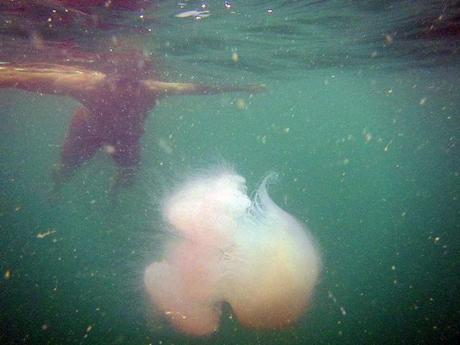
When we explored Malaysia's Bako National Park with our friends from Seattle recently, we started to notice the jellyfish when we were still a few miles from the anchorage near Pulau Lakei. At first we thought the billowing white shapes were plastic bags floating just underwater, a sad commentary on how accustomed we have become to seeing a large volume of trash in the water in Southeast Asia. Upon closer examination, it was clear these ghostly floats were the umbrellas (heads) of jellyfish- not garbage after all.
They moved slowly, drifting with the current, so when the anchor was set we went for a swim to see them first hand. Having recently missed on identifying the highly toxic box jellyfish (oops) and knowing nothing about this species, we were VERY careful to avoid any contact. We could see dozens from the boat, but with visibility and agility skewed heavily in our favor there was minimal risk associated with getting a close-up look.
They were simply gorgeous.

When large numbers are co-located, it's called a bloom, not a swarm. Since jellyfish are an important part of the marine ecosystem, shame on me for using the scare-factor term like 'swarm' instead of the benign and more accurate) bloom. Like other misunderstood marine creatures like sharks, jellyfish need respect- not misinformation!
These big jellies are caught locally for food. We didn't see that in action, but a Canadian conservationist has an interesting writeup with a great series of images on his blog. Our experience sampling jellyfish at a small restaurant in Kuching was... well, not something we need to repeat. It was just very bland, like trying to eat rubberbands. The only flavor was from the incredibly spicy sauce. Excellent sauce, but I can find tastier vehicles for it.
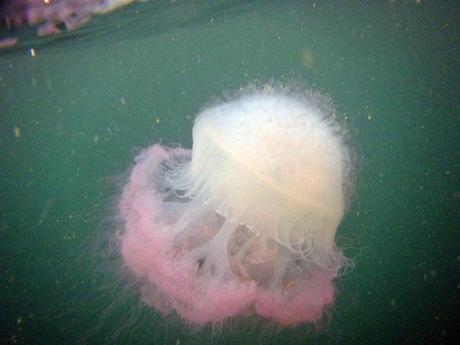
Besides being a source of food for humans, these jellyfish are an even more important food source for turtles and large fish. It's nesting season and we saw a lot of big turtles popping their heads out of the water for a breath of air (between jellyfish snacks no doubt!). The jellies also protect smaller fish from their predators: a number of little fish found refuge among their stinging cells. Honestly, isn't this kind of cute?
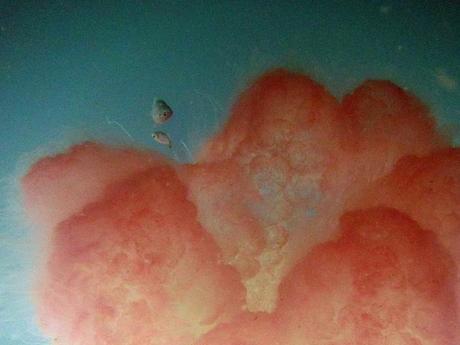
Most of the jellyfish were the large species shown above and in Ronald's blog, predominantly white with delicate pink coloration along the tentacles. Thanks to Christopher Mah and a lively discussion on Facebook, I learned the are probably a sister to Crambione mastigiophora. They weren't the only ones, though. These stunning jellies were much smaller but hello, vibrant! Reminded me of cartoon mushrooms.
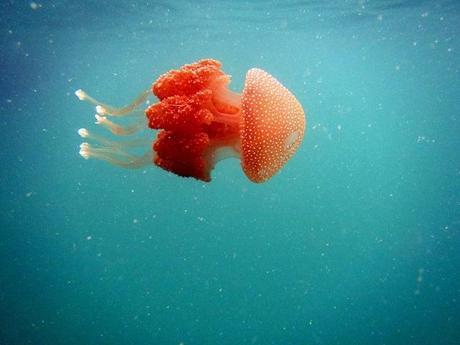
Niall had the idea to take some photos from underneath the jellies. The images of these same big jellyfish seen through the light was startling and beautiful.
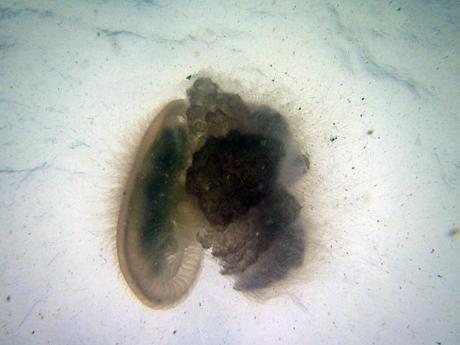
The biologists on Facebook helpfully guided me to a few resources. I'm really looking forward to downloading a species guide when our internet access is good enough. Meanwhile, there's a lot more to learn from Jellywatch. We'll be following them and submitting sightings of blooms there too.

